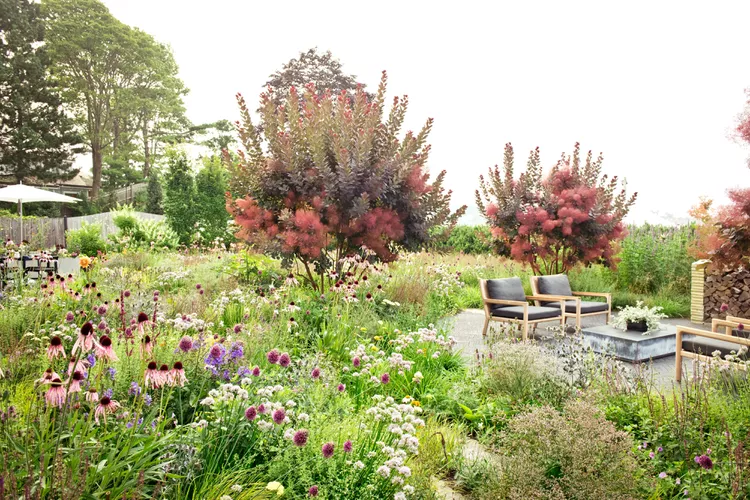Garden trends are slow to change—plants take time to grow, after all—but one landscaping approach has clearly boomed in recent years: Naturalistic garden design. Inspired in part by famous Dutch landscape designer Piet Oudolf, a new wave of American garden designers have applied tenets of his sustainable, wildlife-friendly approach to landscapes of all scales. Here's how to weave key naturalistic garden design ideas into your own backyard in big or small ways.
1. Prioritize Natives and Perennials
Naturalistic garden designers utilize plants that feel at one with their region, as in this prairie-inspired Iowa front yard by garden designer Kelly Norris, author of the book New Naturalism. Those plants are often natives (meaning they evolved naturally in the area), of course, but they can also be perennials that are well-adapted to the particular area. This approach has multiple benefits: It creates a distinct sense of place, it supports local wildlife, and it's more sustainable because it reduces or even eliminates the need for additional water and fertilizer.
Kelly Norris
"Our gardens are not separate from the world around us. Even the smallest patch of green helps connect us to the larger ecological quilt."
2. Focus on Plant Shape and Form
Naturalistic gardens often put a greater emphasis on plant shape and texture than color. That means a thoughtful, balanced mix of more feathery and structured perennials that look good year round, as in this Iowa backyard by garden designer Austin Eischeid, who was heavily influenced by his time working for Piet Oudolf. Color isn't absent from naturalistic gardens, but the palette tends to be tighter and more subdued.
Types of Plants to Use in a Naturalistic Garden
- Groundcovers: They provide a base layer of texture and color.
- Ornamental grasses and sedges: Shorter ornamental grasses and sedges keep the garden looking soft and full, while catching the sunlight in an appealing way. Plant them in clusters for maximum effect.
- Structured plants: Upright perennials as well as small trees and shrubs anchor a space and contrast with the wispier plants in the garden.
- Flowers: A few seasonal stars bring color—and pollinators—to the garden. Coneflowers, alliums and phlox are all popular seasonal exclamation points in naturalistic gardens, but the best choice for your garden are flowers that thrive naturally in your climate.
3. Take Planting Cues from the Wild
A naturalistic landscape in the Southwest will look much different from a Northeast woodland garden or a Midwest backyard. Get ideas for a naturalistic border or garden from the wild landscapes in your region.
4. Create an Organized Plan
While naturalistic gardens may evoke the feeling of an untamed landscape, they are actually quite carefully organized. In landscape designer Adam Woodruff's Massachusetts garden, an approach called matrix planting—an organizational strategy of creating a framework of plants with the same light, water, and soil requirements—creates a pleasing rhythm. Similar to how plants coexist in the wild, this approach makes for a more successful, lower-maintenance garden.
Adam Woodruff
"You have to edit, groom, adjust, and rebalance the garden year to year. But this style of gardening is very forgiving."
5. Plant Densely
Plants are placed closely together and clustered in waves in naturalistic gardens to create a veritable sea of textures, color, and shapes, as in this landscape at the Olbrich Botanical Garden in Madison, Wisconsin, by garden designer Jeff Epping. This approach also has a practical upside: It helps crowd out weeds.
6. Inject Stopping Points
A successful naturalistic garden may be abundant in plants, but it also benefits from some visual pauses and structural elements. Adding container plantings, a bench, or a water feature, like this one in Woodruff's backyard, creates a moment of calm and a sense of civilization.
7. Lose the Lawn
A naturalistic garden plan can replace regular sod—which requires frequent mowing and doesn't benefit wildlife much—with a landscape that's both more interesting and better for the environment. The plants for this California meadow garden by Terremoto were chosen to bring soft color to the front yard and attract plenty of birds, bees, and butterflies.
8. Allow for Self Seeding
Forget the tidy, manicured garden borders of old: Naturalistic-inspired designs allow for spontaneity as they evolve. In this backyard, white pom-poms of 'Alba' sea thrift are left to grow wherever they pop up, even in the middle of a pathway, to charming effect.
9. Skip the Deadheading
Part of the goal of naturalistic garden design is to let plants do their thing as they would in nature. That means, for instance, leaving flower heads on even after they're spent so birds can enjoy their seeds.




















